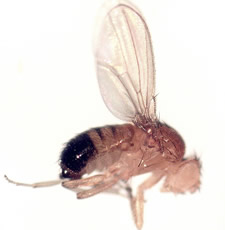UCSD Study Shows 'Junk' DNA Has Evolutionary Importance
October 19, 2005
By: Kim McDonald
Genetic material derisively called “junk” DNA because it does not contain the instructions for protein-coding genes and appears to have little or no function is actually critically important to an organism’s evolutionary survival, according to a study conducted by a biologist at UCSD.

Fruit fly Drosophila melanogaster
In the October 20 issue of Nature, Peter Andolfatto, an assistant professor of biology at UCSD, shows that these non-coding regions play an important role in maintaining an organism’s genetic integrity. In his study of the genes from the fruit fly Drosophila melanogaster, he discovered that these regions are strongly affected by natural selection, the evolutionary process that preferentially leads to the survival of organisms and genes best adapted to the environment.
Andolfatto’s findings are important because the similarity of genome sequences in fruit flies, worms and humans suggest that similar processes are probably responsible for the differences between humans and their close evolutionary relatives.
“Sequencing of the complete genome in humans, fruit flies, nematodes and plants has revealed that the number of protein-coding genes is much more similar among these species than expected,” he says. “Curiously, the largest differences between major species groups appear to be the amount of ‘junk’ DNA rather than the number of genes.”
Using a recently developed population genetic approach, Andolfatto showed in his study that these expansive regions of “junk” DNA—which in Drosophila accounts for about 80 percent of the fly’s total genome—are evolving more slowly than expected due to natural selection pressures on the non-protein-coding DNA to remain the same over time.
“This pattern most likely reflects resistance to the incorporation of new mutations,” he says. “In fact, 40 to 70 percent of new mutations that arise in non-coding DNA fail to be incorporated by this species, which suggests that these non-protein-coding regions are not ‘junk,’ but are somehow functionally important to the organism.”
Andolfatto also found that “junk” regions exhibit an unusually large amount of functional genetic divergence between different species of Drosophila, further evidence that these regions are evolutionarily important to organisms. This implies that, like evolutionary changes to proteins, changes to these “junk” parts of the genome also play an important role in the evolution of new species.
“Protein evolution has traditionally been emphasized as a key facet of genome evolution and the evolution of new species,” says Andolfatto. “The degree of protein sequence similarity between humans and chimpanzees, and other closely-related but morphologically distinct taxa, has prompted several researchers to speculate that most adaptive differences between taxa are due to changes in gene regulation and not protein evolution. My results lend support to this view by demonstrating that regulatory changes have been of great importance in the evolution of new Drosophila species.”
